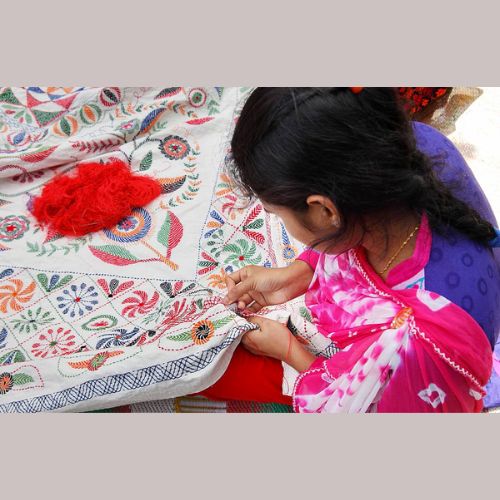Kantha, much more than just a textile craft, is an ancestral tradition originating in Bengal—a region now shared between India and Bangladesh. This know-how, passed down from generation to generation, is both an art of reclamation and a unique form of cultural expression.
A tradition born of simplicity and ingenuity
The word Kantha means “rag” in Sanskrit. This technique was born from the reuse of old fabrics, especially worn saris, which women superimposed in several layers (up to 6), then embroidered by hand with a simple stitch, the running stitch. This humble gesture gave rise to blankets, tablecloths or clothing of touching beauty.
A narrative art: Nakshi Kantha
Beyond the usefulness, the Kantha is also a language. The Nakshi Kantha, a more artistic and figurative form, allowed women to express their emotions, tell personal stories, and even document their daily lives. Each thread, each pattern, each color has its meaning. A Kantha embroidery is often much more than an object: it is a fragment of life, a cultural testimony.
A living and committed tradition
Today, Kantha continues to evolve. It has become a popular element of ethical fashion and interior design. Kantha clothing, cushions, bags, and throws are part of a bohemian, sustainable, and artisanal aesthetic. But above all, this craftsmanship plays an essential social role: it allows many women in Bangladesh to achieve economic independence. In the Sylhet region, in particular, cooperatives actively support this sector.
Where to find Kantha in France or Europe?
It is possible to obtain authentic Kantha pieces in France and Europe via fair trade shops, craft markets or ethical fairs...
Honoring the thread of memory
Kantha isn't just a textile art. It's a living heritage, a thread that connects women, families, and cultures. By choosing a Kantha piece, you're purchasing more than just an object: you're supporting hands, stories, and dignity. And you're helping to preserve a world heritage treasure.

